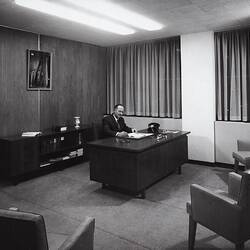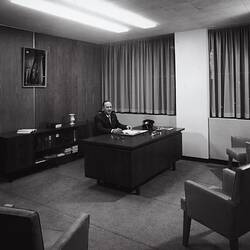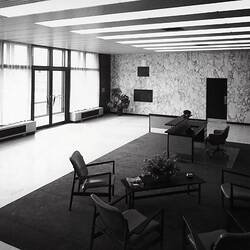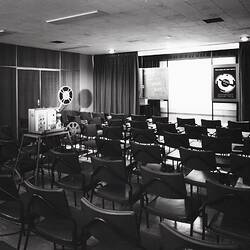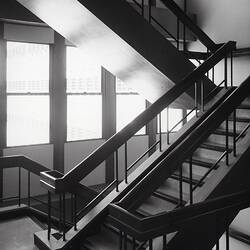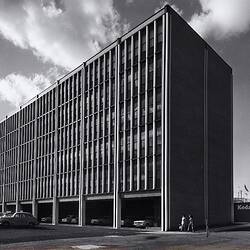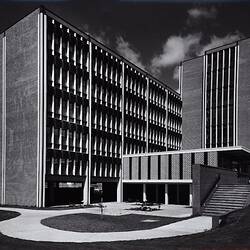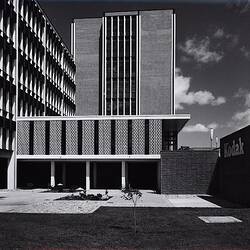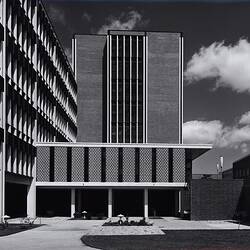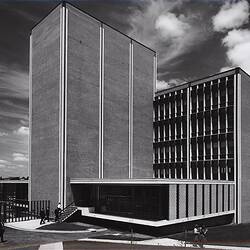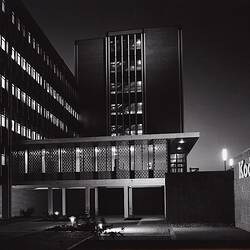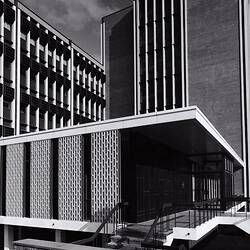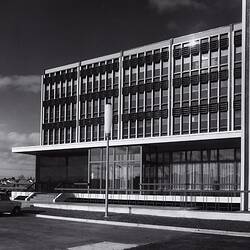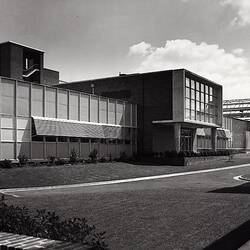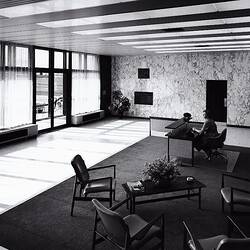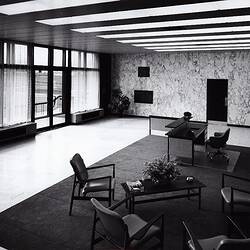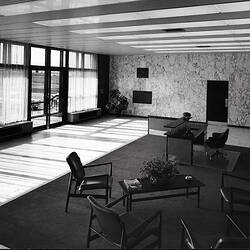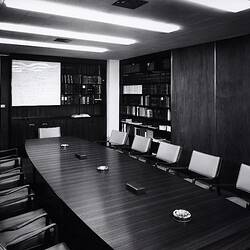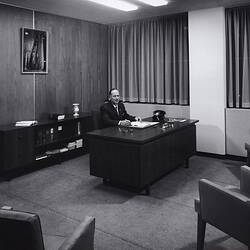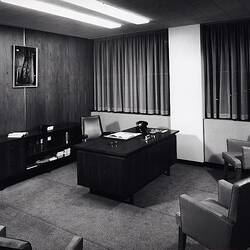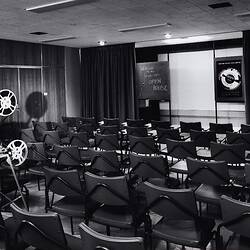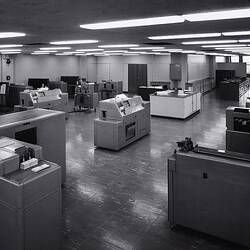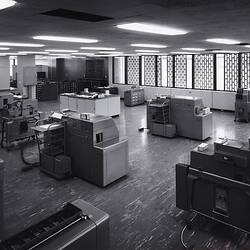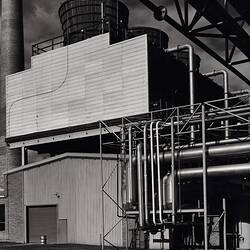Wolfgang Georg Sievers was an acclaimed architectural and industrial photographer, both in Australia and internationally. His photographic oeuvre in Australia encompasses architecture, manufacturing industries, mining and workers from 1938 through to 1991.
Sievers was born on 18 September 1913 in Berlin, Germany. His father Johannes Sievers (1880-1969) was an art historian and Director of Cultural Affairs in the Weimar Government, and his mother Herma Sievers, née Schiffer (1882-1932) was a writer who also ran an Institute of Educational Films.
Sievers initially learnt photography by illustrating his father's books on the German architect, Karl Friedrich Schinkel (1781-1841). He received his formal photographic training at the Contempora School for Applied Arts in Berlin from 1936 to 1938, where he also became an instructor. The Contempora was an offshoot of the Bauhaus in Weimar. The Bauhaus, founded by Walter Gropius in 1919, was an innovative educational institution. Central to its philosophy was the unity of art, craft and technology, and the artist serving a social role. As a result, Sievers' work was steeped in European Modernism and the New Objectivity movement prevalent in Germany and Russia, with its aesthetic of clean lines, pronounced camera angles, geometric forms, and subjects focused on modern life, industry and the machine.
Sievers left Nazi Germany to escape war service and persecution for his Jewish descent, migrating to Australia in 1938. He settled in Melbourne in 1939, establishing his photographic studio in South Yarra. His earliest clients were from the architectural and industrial fields, and in 1939 he received assignments from the Charles Ruwolt engineering works (later Vickers Ruwolt) and Bryant & May in Melbourne. With the outbreak of World War II, the Australian Government classified Sievers as an enemy alien, complicating his efforts to find commercial work. During this time he took portraits of members of the Armed Forces. Sievers was eventually given permission to serve as a volunteer with the Australian Imperial Forces in 1942, and was later demobilized in 1946. He became an Australian citizen in 1944.
On arrival, Sievers noted that Australian photography was mired in nineteenth century pictorialism. Sievers' work was immediately distinctive as he applied a modernist aesthetic to his commercial work. From the 1950s through to the 1970s, given his interest in the relationship of man with machine and the machine with the landscape, Sievers sought work with the Department of Trade in Canberra and the burgeoning industrial sector, working with manufacturers and mining companies including Shell, Comalco, BHAS (Broken Hill Associated Smelters), Australian Pulp and Paper Manufacturers, Hamersley Iron, John Holland, John Lysaght and Alcoa. Through his photographic assignments incorporating advertisements, journal publications and annual company and government reports, Sievers assisted in promoting post-war Australia as a progressive, modern industrial and commercial force on the international stage. For instance, in the 1950s he was give a major commission from the Department of Overseas Trade with the specific brief to change Australia's image from one of 'sheep and wool' to that of a sophisticated nation based on manufacturing and industry.
Sievers was also inspired to photograph the work of Australian modernist architects exhibiting what he termed 'clean forms and wonderful shapes', such as Frederick Romberg, Robin Boyd, Harry Seidler, Yuncken Freeman, Bates Smart & McCutcheon, Peter McIntyre, Alex Jelinek, Winston Hall, Leith & Bartlett and David McGlashan. His architectural photography spanned corporate architecture to private residences.
Sievers made a unique contribution to Australian photography, with his view of the dignity of the worker in modern life, photographing workers from a range of industries alongside the machinery of their working environments. Later in his photography career, Sievers became concerned with the impact industries such as mining had on the natural environment. This issue, as well as the increase in mechanized and computerised work settings reducing the need for people to perform many tasks, resulted in Sievers questioning his involvement as a photographer in the areas of manufacturing and heavy industry. Towards the end of the 1980s Sievers discontinued taking industrial photographs.
Throughout his life Sievers was a passionate advocate for human rights and an anti-war activist. In 1967 he protested Australia's involvement in the Vietnam War. During the 1990s, Sievers compiled evidence of Nazi war criminals seeking refuge in Australia for the Australian Government and for the Simon Wiesenthal Jewish Documentation Center in Vienna. Sievers was awarded an Officer of the Order of Australia (AO) in 2002 for his services to photography. He passed away on 7 August 2007 Melbourne, Victoria.
Sievers took several hundred black and white and colour images of the Kodak factory in Coburg. His images characteristically highlight the modern architectural and industrial design features of the complex. A selection of these images now forms a significant component of the Kodak Heritage Collection at Museum Victoria.
The National Library of Australia holds Sievers' negative archive and the State Library of Victoria holds his print collection. Sievers' work is also represented in major institutions such as the National Gallery of Victoria, Art Gallery of New South Wales and the Powerhouse Museum.
Related Resources
- Sievers Collection at the National Library of Australia
- Wolfgang Sievers Collection at the State Library of Victoria
References
Calado, Jorge 2000, A fotografia de Wolfgang Sievers 1933-1993: linha de vida = life line, Camara Municipal de Lisboa, Lisbon
Crombie, Isobel 2008, 'Industralia: The Photography of Wolfgang Sievers' in Stephen, Ann, Goad, Philip & McNamara, Andrew (eds), Modern times: the untold story of modernism in Australia, Miegunyah Press, Carlton, Vic, pp.144-147
Ennis, Helen 2011, Wolfgang Sievers, National Library of Australia, Canberra
Ennis, Helen 2004, Intersections: Photography, History and the National Library of Australia, National Library of Australia, Canberra
Gollings, John 2007, 'Obituary: Vale Wolfgang Sievers 1913-2007', Architecture Australia, November/December
Newton, Gael 1980, Silver and grey: fifty years of Australian photography, 1900-1950, Angus & Robertson, London; Sydney
Sievers, Wolfgang & York, Barry (Interviewer) 2000, Wolfgang Sievers interviewed by Barry York, Sandringham, Vic, 20 March, National Library of Australia, Canberra
Sievers, Wolfgang & McKenzie, Ian 1998, Wolfgang Sievers, Writelight, Neutral Bay, N.S.W
More Information
-
Keywords
Photographers, World War II, Photography, industrial photography, German Immigration, Engineering Industry, Australian Manufacturing Industry, Industry, Architecture, Vietnam War, 1959-1975, Protests, Human Rights, Social Conditions
-
Localities
-
Authors
-
Article types


